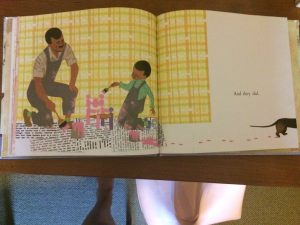Peter’s Chair
Written and illustrated by Ezra Jack Keats
Harper Collins, 1967
28 pages, Realistic Fiction
In Peter’s Chair, the protagonist of Snowy Day, Peter, learns that he has to make some changes to his life because of his new baby sister. When Peter is playing, his mother tells him that he must play more quietly because Susie is sleeping. Later, Peter’s father is painting Peter’s old high chair pink and has already painted his cradle pink for the new baby. Peter is upset that his belongings are being taken over by his baby sister, so when he sees his little chair, he brings it to his room before it can be painted pink. He then gathers his dog Willie, his blue chair, his toy crocodile, a picture of himself as a baby, and some cookies and dog biscuits and runs away to his front yard. However, when Peter tries to sit in his chair, he realizes that he is too big for the chair. After this, Peter comes back home and asks his father if he can help paint his little chair pink for his sister.
This book serves primarily as a mirror for children who have recently become older siblings and who might have trouble adapting to the changes that come with having a new baby in the family. Because the language is not too complex, with mostly simple sentences and pictures that mirror the text, this book would be appropriate for very young children who need to be read to or slightly older children who are beginning to read on their own. Peter is also an African-American boy, so reading this story, and all of the Peter stories, can be a mirror for other African-American children. Although Peter’s Chair does not deal with racism or stereotypes, this representation can be helpful for children who do not see themselves in the books that they read. The story focuses more on the way that Peter reacts to not being an only child anymore, so although there is not a direct cultural connection, Peter’s Chair can help children see how one boy handles becoming an older sibling.
Ezra Jack Keats does his illustrations in a variety of mediums, most of which are paint based. Some of his works, including Peter’s Chair, feature collage, which gives the images in the book depth. The collage feature is most notable on the last page, when Peter and his father are painting the little chair pink, and there are newspapers on the floor. Keats used actual newspaper clippings to create this image, and readers can see that the newspapers are on top of the floor. For beginning readers, this technique of painting and collage makes the images look interesting and keeps their attention. Keats also used bright colors, especially for Peter’s clothing and his sister’s new furniture, so the colors also catch the attention of the readers.
The Peter books are often discussed because Peter is an African-American character written by a white author. While Peter is one of the first African-American children’s book characters, many critics question if Keats can accurately tell Peter’s story because he has not lived the experience that Peter would have had. There is also the question of what is missing in the story, because Keats does not mention any questions of discrimination or racism that Peter might face. While one could argue that talking about racism does not fit into the story, other people could see this as a move that Keats made to gloss over struggles that Peter might experience.



